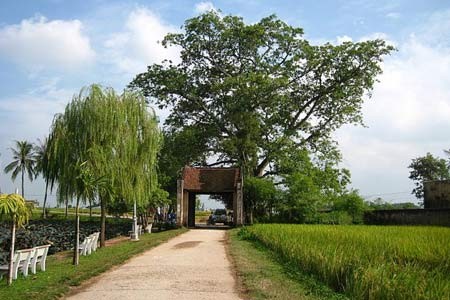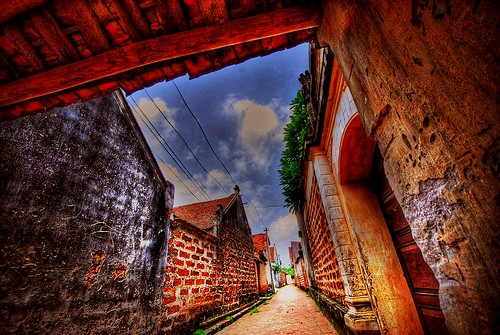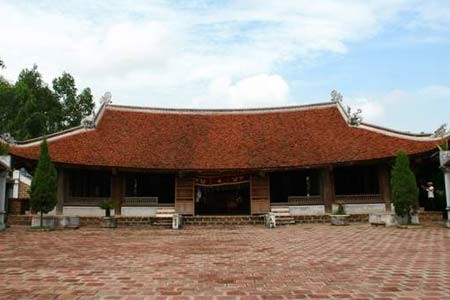(VOVworld) - Located in Sơn Tây Town, 40 km to the west of Hanoi, Đường Lâm village is a very popular tourist destination at the weekends. The village attracts visitors because of its ancient houses and the architectural features of a typical old Vietnamese village with banyan trees and a wharf on the river. Join us on a tour of Đường Lâm village with reporter Lan Anh.
 |
| The village gate is strongly imbued with architectural features of the Viet old village with banyan tree, river wharf…(Photo: www.vietbao.vn) |
It takes just over an hour to get to Đường Lâm village. On the road leading up to the village, tourists can feel the peaceful atmosphere. The rice fields these days are in their prime while lotus ponds will soon be in bloom signaling the coming of the summer. Passing through the village gate to Mông Phụ village, visitors should not miss taking photo of the gate, which is in the typical architectural style of an old Vietnamese village. Nguyễn Trọng An is Deputy Head of the village’s Management Board '
Of the 5 hamlets in Đường Lâm village, Mông Phụ is seen as the center, as it has many historical sites including communal houses, old houses, and the clan’s worshipping house. Of course, the 4 remaining hamlets also have important relics, a regular must-see for tourists'.
 |
| Đường Lâm village has ancient houses in Đông Sàng, Mông Phụ and Cam Có Hamlets dating back up to the 17th century (Photo: www.unitour.com) |
Đường Lâm village has a history dating back about 1,200 years with many houses in Đông Sàng, Mông Phụ
and Cam Có Hamlets built in the 17
th century. Visitors to the village often visit the houses in Mông Phụ, which are said to be the most beautiful and more specifically, their owners will spend time showing people around their beloved houses. Nguyễn Thị Thu Hoài is a tour guide for the village’s Management Board '
The architecture of all the houses there is the same, with rows of columns and spans. In the past, only wealthy people or landlords could build such big houses. The big wooden house often has 5 or 7 spans with 2 wings. The houses of civilian and military mandarins are often different to each other. In a civilian mandarin’s house, there are many horizontal lacquered boards and parallel sentences while in a military mandarin’s house, either dragon-shaped patterns or contemporary designs dominate'.
 |
| Communal House of Mong Phu Hamlet (Photo: www.vietbao.vn) |
Each ancient house in Đường Lâm Village is worth a look. The house owned by Ms. Vũ Thị Ấm in Đông Sàng hamlet with a special worshipping space is a good example. This special place is carved in a dragon-head pattern. Meanwhile, the house of Mr. Kiều Anh Ban was built in 750 under the reign of King Lê Hiển Tông, with everything intact, even the wooden doors. Ban said the worshipping space is the house’s specialty adding 'We still keep the worshipping space intact to worship our ancestors. A perfect compartment is divided into 4 levels of worshipping. The farthest level is used to show photos. It’s followed by an ancestral tablet, a worshipping plank bed to display offerings and an incense table. After praying, the offerings put on the plank bed will be taken down for family members to enjoy. For years, we have maintained this ritual'.
Apart from its ancient houses, tourists going to Đường Lâm village can visit Mía Pagoda and Mông Phụ Communal House or tour a traditional craft village. Lê Thị Kim Nhung is a villager 'We have many traditional craft villages and well-known products. Our cakes include glutinous rice doughnuts, Chung cakes, and rice cakes filled with brown onions. Widely loved are our peanuts and sesame sweets as well s our carpentry and forging skills. We want to develop our the age-old traditions, so that visitors to Đường Lâm will buy our products instead of only visiting traditional craft villages'.
Đường Lâm is also famous for its soybean sauce which is second only to Bần soybean sauce in Hưng Yên province. Aiko, a Japanese volunteer, shows her keen interest in the local dishes and says 'The first time I visited Đường Lâm, I was impressed by the scenery but the local people didn’t know how to give guided tours. It has changed now. There are many old and traditional houses there and more importantly, the villagers know their own culture and customs very well, so they guide any visitors. Besides, I’m very interested in locally-made dishes. I like the local confectionary such as the peanut and sesame sweets, the ‘Chè lam’ made of roasted sticky rice powder, ginger, peanuts, and malt and the soft green lentil cakes'.
If you want to visit Đường Lâm, you can take a bus from Hanoi to Sơn Tây town, then go by bicycle or motorbike to explore the area, visit the old houses and other sites then return to Hanoi the same day.
Lan Anh